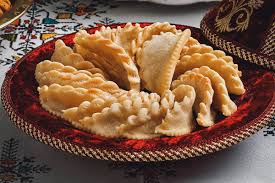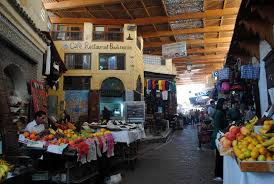The Exquisite Flavours of Moroccan Cuisine
When it comes to culinary delights, few cuisines can rival the exotic and fragrant dishes of Morocco. A fusion of Berber, Arab, and Mediterranean influences, Moroccan cuisine is a tantalising journey for the taste buds. Let’s explore some of the most iconic dishes that make Moroccan food a true gastronomic adventure.
Tagine
Arguably the most famous Moroccan dish, tagine is named after the earthenware pot in which it is cooked. This slow-cooked stew typically features tender meat (such as lamb or chicken), aromatic spices like cumin and cinnamon, dried fruits, and vegetables. The result is a melting pot of flavours that embodies the essence of Moroccan cooking.
Couscous
Couscous holds a special place in Moroccan cuisine as a staple dish enjoyed across the country. This fluffy semolina pasta is steamed to perfection and served with a savoury stew made from meat or vegetables. The delicate texture of couscous combined with the rich flavours of the accompanying sauce creates a harmonious balance that delights every palate.
Pastilla
A true delicacy, pastilla is a savoury-sweet pastry that showcases the intricate blend of flavours in Moroccan cooking. Traditionally made with pigeon meat (though chicken is commonly used today), almonds, spices, and layers of thin pastry dusted with icing sugar and cinnamon, pastilla offers a unique taste experience that epitomises Morocco’s culinary artistry.
Harira
Harira is more than just a soup—it’s a symbol of Moroccan hospitality and tradition. This hearty soup features tomatoes, lentils, chickpeas, herbs, and spices simmered to perfection. Often enjoyed during Ramadan to break the fast at sunset, harira warms both body and soul with its comforting blend of flavours.
Mint Tea
No exploration of Moroccan cuisine would be complete without mentioning mint tea—known as “Moroccan whiskey” for its ubiquitous presence in social gatherings. Brewed with fresh mint leaves and an abundance of sugar poured from great heights to create frothiness, this sweet and refreshing tea is an integral part of Moroccan culture and hospitality.
From the aromatic spices to the intricate flavour combinations, Moroccan cuisine offers a sensory feast that transports you to the bustling markets and sun-drenched landscapes of this North African gem. Whether you’re savouring tagine in Marrakech or sipping mint tea in Casablanca, each bite tells a story steeped in centuries-old tradition and culinary mastery.
Exploring Moroccan Cuisine: Answers to 8 Frequently Asked Questions on Traditional Dishes and Ingredients
- What is tagine and what are the traditional ingredients used?
- How is couscous prepared in Moroccan cuisine?
- What is pastilla and what makes it a popular dish in Morocco?
- Can you explain the significance of harira soup in Moroccan culture?
- What spices are commonly used in Moroccan dishes?
- Are there vegetarian or vegan options available in Moroccan cuisine?
- How is mint tea traditionally served in Morocco?
- Which regions of Morocco are known for specific culinary specialties?
What is tagine and what are the traditional ingredients used?
Tagine is a quintessential Moroccan dish that embodies the essence of slow-cooked comfort food. Named after the earthenware pot in which it is prepared, tagine typically features tender meat—such as lamb or chicken—infused with a medley of aromatic spices like cumin, cinnamon, and paprika. Traditional ingredients used in tagine also include dried fruits such as apricots or prunes, vegetables like carrots and potatoes, and a hint of sweetness from honey or preserved lemons. The unique combination of savoury and sweet flavours simmered together creates a rich and fragrant stew that is both hearty and satisfying, making tagine a beloved symbol of Moroccan culinary tradition.
How is couscous prepared in Moroccan cuisine?
In Moroccan cuisine, couscous is prepared with meticulous care and attention to detail. The process begins by steaming the couscous grains, traditionally made from semolina, in a special pot called a couscoussier. The steaming is done in multiple stages to achieve the perfect light and fluffy texture that couscous is known for. Once cooked, the couscous is typically served with a flavourful stew made from a variety of ingredients such as meat (often lamb or chicken), vegetables, chickpeas, and an array of aromatic spices like cumin, turmeric, and paprika. This harmonious combination of tender grains and savoury sauce creates a dish that embodies the essence of Moroccan culinary artistry.
What is pastilla and what makes it a popular dish in Morocco?
Pastilla, a traditional Moroccan dish, is a savoury-sweet pastry that has captured the hearts and palates of locals and visitors alike. Made with layers of thin pastry filled with a delectable mixture of spiced meat (often chicken or pigeon), almonds, eggs, and a hint of sweetness from icing sugar and cinnamon, pastilla offers a unique flavour profile that blends savoury and sweet elements in perfect harmony. What sets pastilla apart is not just its exquisite taste but also its cultural significance—it symbolises hospitality, celebration, and the artistry of Moroccan cuisine. The delicate balance of flavours and textures in pastilla reflects the diverse influences that shape Moroccan culinary traditions, making it a standout dish that embodies the essence of Morocco’s rich gastronomic heritage.
Can you explain the significance of harira soup in Moroccan culture?
Harira soup holds a significant place in Moroccan culture as more than just a dish—it is a symbol of tradition, hospitality, and togetherness. Particularly enjoyed during the holy month of Ramadan to break the fast at sunset, harira represents nourishment for both the body and soul. Its rich blend of tomatoes, lentils, chickpeas, herbs, and spices not only provides sustenance but also embodies the warmth and generosity of Moroccan hospitality. The preparation and sharing of harira soup bring families and communities together, fostering a sense of unity and connection that transcends the boundaries of the dining table. In essence, harira soup is a culinary cornerstone that reflects the deep-rooted values and customs that define Moroccan culture.
What spices are commonly used in Moroccan dishes?
Moroccan cuisine is renowned for its vibrant and aromatic flavours, largely due to the skilful use of a variety of spices. Some of the most commonly used spices in Moroccan dishes include cumin, paprika, cinnamon, ginger, turmeric, and saffron. These spices not only add depth and richness to the dishes but also reflect the diverse cultural influences that have shaped Moroccan cooking over centuries. Whether it’s the warm notes of cinnamon in a tagine or the earthy kick of cumin in couscous, each spice plays a crucial role in creating the exquisite tapestry of flavours that define Moroccan cuisine.
Are there vegetarian or vegan options available in Moroccan cuisine?
For those seeking vegetarian or vegan options in Moroccan cuisine, there is a delightful array of dishes that cater to plant-based diets. From hearty vegetable tagines bursting with spices and flavours to fragrant couscous dishes brimming with seasonal produce, Moroccan cuisine offers a rich tapestry of meat-free and dairy-free options. Enjoy savoury lentil soups, vibrant salads dressed with citrusy vinaigrettes, and crispy falafel served alongside zesty dips. Embrace the diversity of Moroccan culinary traditions that celebrate the bounty of the earth in every delectable bite.
How is mint tea traditionally served in Morocco?
In Morocco, mint tea is not just a beverage—it’s a symbol of hospitality and tradition deeply ingrained in the country’s culture. Traditionally served in small, ornate glasses, the tea is prepared by steeping fresh mint leaves with green tea and an abundance of sugar. The tea is then poured from a height into the glasses to create a frothy layer on top, enhancing both the flavour and presentation. Sipped slowly and savoured over lively conversations, sharing mint tea in Morocco is a cherished ritual that fosters connection and warmth among friends and guests alike.
Which regions of Morocco are known for specific culinary specialties?
Morocco’s diverse regions each boast their own culinary specialties, adding a rich tapestry of flavours to the country’s gastronomic landscape. The coastal city of Essaouira is renowned for its fresh seafood dishes, such as grilled sardines and fish tagines, reflecting the bounty of the Atlantic Ocean. In the north, Tangier showcases a fusion of Moroccan and Mediterranean influences, with dishes like pastilla and lamb kebabs taking centre stage. The bustling souks of Marrakech offer a plethora of street food delights, from fragrant lamb mechoui to crispy pastries filled with spiced meats. Heading south to the Sahara Desert, you’ll find hearty dishes like Berber tagine and couscous made with aromatic spices and dried fruits. Each region of Morocco tells its own culinary story, inviting travellers on a tantalising journey through its unique flavours and traditions.




